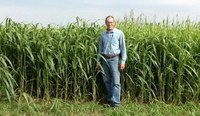– John F. Grimes, OSU Extension Beef Coordinator
For the past few years, beef cattle producers have been receiving strong economic signals to increase the size of the nation’s cow herd. While recent market prices have been historically high, expansion has been limited across much of the country due to large areas of significant drought. However, the situation has changed to the point where drought conditions currently exist only in the far west and in the southern tip of Florida.
Based on last week’s release of the U.S. Department of Agriculture’s National Agricultural Statistics Service semi-annual Cattle report, expectations have become Continue reading When Expectations Become Reality
